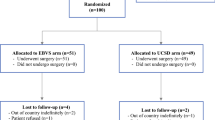Abstract
Bleeding is a major complication of thyroid surgery. A retrospective study was performed comparing the outcomes of patients undergoing thyroid surgery where bipolar diathermy with standard bipolar forceps was used for vessel ligation (n = 64) compared to clamp-and-tie (n = 89). Fewer drains were inserted and patients were discharged earlier when standard bipolar diathermy was used for vessel ligation in hemithyroidectomies (P < 0.001). Complication rates were similar. The use of bipolar diathermy with standard forceps for vessel ligation in thyroid surgery has been shown to be as safe and effective as the clamp-and-tie technique, while resulting in earlier patient discharge. This technique is cost-efficient as it provides the advantage of reduced inpatient stay reported using bipolar vessel sealing devices or the harmonic scalpel, but without the additional expense.


Similar content being viewed by others
References
Franko J, Kish KJ, Pezzi CM, Pak H, Kukora JS (2006) Safely increasing the efficiency of thyroidectomy using a new bipolar electrosealing device (LigaSure) versus conventional clamp-and-tie technique. Am Surg 72(2):132–136
Manouras A, Markogiannakis H, Koutras AS, Antonakis PT, Drimousis P, Lagoudianakis EE, Kekis P, Genetzakis M, Koutsoumanis K, Bramis I (2008) Thyroid surgery: comparison between the electrothermal bipolar vessel sealing system, harmonic scalpel, and classic suture ligation. Am J Surg 195(1):48–52. doi:10.1016/j.amjsurg.2007.01.037
Dror A, Salim M, Yoseph R (2003) Sutureless thyroidectomy using electrothermal system: a new technique. J Laryngol Otol 117(3):198–201. doi:10.1258/002221503321192502
Shen WT, Baumbusch MA, Kebebew E, Duh QY (2005) Use of the electrothermal vessel sealing system versus standard vessel ligation in thyroidectomy. Asian J Surg 28(2):86–89
Manouras A, Lagoudianakis EE, Antonakis PT, Filippakis GM, Markogiannakis H, Kekis PB (2005) Electrothermal bipolar vessel sealing system is a safe and time-saving alternative to classic suture ligation in total thyroidectomy. Head Neck 27(11):959–962. doi:10.1002/hed.20271
Lachanas VA, Prokopakis EP, Mpenakis AA, Karatzanis AD, Velegrakis GA (2005) The use of Ligasure Vessel Sealing System in thyroid surgery. Otolaryngol Head Neck Surg 132(3):487–489. doi:10.1016/j.otohns.2004.09.020
Saint Marc O, Cogliandolo A, Piquard A, Fama F, Pidoto RR (2007) LigaSure vs clamp-and-tie technique to achieve hemostasis in total thyroidectomy for benign multinodular goiter: a prospective randomized study. Arch Surg 142(2):150–156. doi:10.1001/archsurg.142.2.150 discussion 157
Cordon C, Fajardo R, Ramirez J, Herrera MF (2005) A randomized, prospective, parallel group study comparing the harmonic scalpel to electrocautery in thyroidectomy. Surgery 137(3):337–341. doi:10.1016/j.surg.2004.09.011
Kilic M, Keskek M, Ertan T, Yoldas O, Bilgin A, Koc M (2007) A prospective randomized trial comparing the harmonic scalpel with conventional knot tying in thyroidectomy. Adv Ther 24(3):632–638. doi:10.1007/BF02848788
Siperstein AE, Berber E, Morkoyun E (2002) The use of the harmonic scalpel vs conventional knot tying for vessel ligation in thyroid surgery. Arch Surg 137(2):137–142. doi:10.1001/archsurg.137.2.137
Erbil Y, Barbaros U, Issever H, Borucu I, Salmaslioglu A, Mete O, Bozbora A, Ozarmagan S (2007) Predictive factors for recurrent laryngeal nerve palsy and hypoparathyroidism after thyroid surgery. Clin Otolaryngol 32(1):32–37. doi:10.1111/j.1365-2273.2007.01383.x
Corsten M, Johnson S, Alherabi A (2005) Is suction drainage an effective means of preventing hematoma in thyroid surgery? A meta-analysis. J Otolaryngol 34(6):415–417. doi:10.2310/7070.2005.34609
Rosato L, Avenia N, Bernante P, De Palma M, Gulino G, Nasi PG, Pelizzo MR, Pezzullo L (2004) Complications of thyroid surgery: analysis of a multicentric study on 14,934 patients operated on in Italy over 5 years. World J Surg 28(3):271–276. doi:10.1007/s00268-003-6903-1
Kiriakopoulos A, Dimitrios T, Dimitrios L (2004) Use of a diathermy system in thyroid surgery. Arch Surg 139(9):997–1000. doi:10.1001/archsurg.139.9.997
Debry C, Renou G, Fingerhut A (1999) Drainage after thyroid surgery: a prospective randomized study. J Laryngol Otol 113(1):49–51. doi:10.1017/S0022215100143129
Hurtado-Lopez LM, Lopez-Romero S, Rizzo-Fuentes C, Zaldivar-Ramirez FR, Cervantes-Sanchez C (2001) Selective use of drains in thyroid surgery. Head Neck 23(3):189–193. doi:0.1002/1097-0347(200103)23:3<;189::AID-HED1017>;3.0.CO;2-Y
Khanna J, Mohil RS (2005) Chintamani, Bhatnagar D, Mittal MK, Sahoo M, Mehrotra M, Is the routine drainage after surgery for thyroid necessary? A prospective randomized clinical study. BMC Surg 5:11. doi:10.1186/1471-2482-5-11 ISRCTN63623153
Lee SW, Choi EC, Lee YM, Lee JY, Kim SC, Koh YW (2006) Is lack of placement of drains after thyroidectomy with central neck dissection safe? A prospective, randomized study. Laryngoscope 116(9):1632–1635. doi:10.1097/01.mlg.0000231314.86486.be
Suslu N, Vural S, Oncel M, Demirca B, Gezen FC, Tuzun B, Erginel T, Dalkilic G (2006) Is the insertion of drains after uncomplicated thyroid surgery always necessary? Surg Today 36(3):215–218. doi:10.1007/s00595-005-3129-x
Schoretsanitis G, Melissas J, Sanidas E, Christodoulakis M, Vlachonikolis JG, Tsiftsis DD (1998) Does draining the neck affect morbidity following thyroid surgery? Am Surg 64(8):778–780
Samraj K, Gurusamy KS (2007) Wound drains following thyroid surgery. Cochrane Database Syst Rev 4:CD006099
Lo CY, Kwok KF, Yuen PW (2000) A prospective evaluation of recurrent laryngeal nerve paralysis during thyroidectomy. Arch Surg 135(2):204–207. doi:10.1001/archsurg.135.2.204
Chan WF, Lang BH, Lo CY (2006) The role of intraoperative neuromonitoring of recurrent laryngeal nerve during thyroidectomy: a comparative study on 1000 nerves at risk. Surgery 140(6):866–872. doi:10.1016/j.surg.2006.07.017 discussion 872–863
Liboon J, Funkhouser W, Terris DJ (1997) A comparison of mucosal incisions made by scalpel, CO2 laser, electrocautery, and constant-voltage electrocautery. Otolaryngol Head Neck Surg 116(3):379–385. doi:10.1016/S0194-5998(97)70277-8
Inaba H, Kaneko Y, Ohtsuka T, Ezure M, Tanaka K, Ueno K, Takamoto S (2000) Minimal damage during endoscopic latissimus dorsi muscle mobilization with the harmonic scalpel. Ann Thorac Surg 69(5):1399–1401. doi:10.1016/S0003-4975(00)01136-X
Miller CE, Johnston M (1996) Reduction of thermal spread and tissue adherence with an irrigating bipolar grasper. J Am Assoc Gynecol Laparosc 3(4(Supplement)):31. doi:10.1016/S1074-3804(96)80241-6
Conflict of interest statement
The authors have no financial conflicts of interest.
Author information
Authors and Affiliations
Corresponding author
Rights and permissions
About this article
Cite this article
Tysome, J.R., Hassan, R. & Davis, J. Standard bipolar diathermy forceps vessel ligation is safe in thyroidectomy. Eur Arch Otorhinolaryngol 266, 1781–1786 (2009). https://doi.org/10.1007/s00405-009-0925-8
Received:
Accepted:
Published:
Issue Date:
DOI: https://doi.org/10.1007/s00405-009-0925-8




